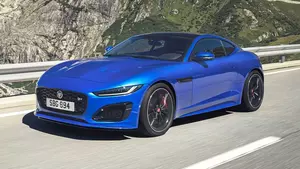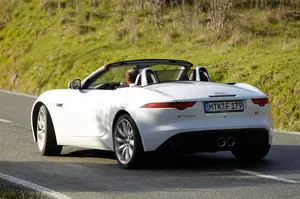
| Vehicle | Curb weight | Difference from world's smallest | Weight to power ratio | 0—60 mph acceleration ratio | Consumption ratio |
|---|---|---|---|---|---|
| SVR 5.0 V8 |
1645 kg / 3627 lbs |
1220 kg (2690 lbs) heavier | 3 kg to 1 hp | 470 kg/s (1036 lbs/s) |
151 kg/L (333 lbs/L) |
| 3.0 V6 |
1614 kg / 3559 lbs |
1189 kg (2622 lbs) heavier | 4 kg to 1 hp | 343 kg/s (756 lbs/s) |
188 kg/L (415 lbs/L) |
| R 5.0 V8 |
1670 kg / 3682 lbs |
1245 kg (2745 lbs) heavier | 3 kg to 1 hp | 428 kg/s (944 lbs/s) |
153 kg/L (337 lbs/L) |
| 2.0 |
1545 kg / 3407 lbs |
1120 kg (2470 lbs) heavier | 5 kg to 1 hp | 286 kg/s (631 lbs/s) |
215 kg/L (474 lbs/L) |
| P300 |
1470 kg / 3241 lbs |
1045 kg (2304 lbs) heavier | 5 kg to 1 hp | 272 kg/s (600 lbs/s) |
186 kg/L (410 lbs/L) |
| P340 V6 |
1522 kg / 3356 lbs |
1097 kg (2419 lbs) heavier | 4 kg to 1 hp | 304 kg/s (670 lbs/s) |
155 kg/L (342 lbs/L) |
| P380 V6 |
1619 kg / 3570 lbs |
1194 kg (2633 lbs) heavier | 4 kg to 1 hp | 337 kg/s (743 lbs/s) |
159 kg/L (351 lbs/L) |
| Vehicle | SVR 5.0 V8 |
|---|---|
| Curb weight |
1645 kg / 3627 lbs |
| Difference from world's smallest | 1220 kg (1220 lbs) heavier |
| Weight to power ratio | 3 kg to 1 hp |
| 0—60 mph acceleration ratio | 470 kg/s (1036 lbs/s) |
| Consumption ratio |
151 kg/L (333 lbs/L) |
| Vehicle | 3.0 V6 |
| Curb weight |
1614 kg / 3559 lbs |
| Difference from world's smallest | 1189 kg (1189 lbs) heavier |
| Weight to power ratio | 4 kg to 1 hp |
| 0—60 mph acceleration ratio | 343 kg/s (756 lbs/s) |
| Consumption ratio |
188 kg/L (415 lbs/L) |
| Vehicle | R 5.0 V8 |
| Curb weight |
1670 kg / 3682 lbs |
| Difference from world's smallest | 1245 kg (1245 lbs) heavier |
| Weight to power ratio | 3 kg to 1 hp |
| 0—60 mph acceleration ratio | 428 kg/s (944 lbs/s) |
| Consumption ratio |
153 kg/L (337 lbs/L) |
| Vehicle | 2.0 |
| Curb weight |
1545 kg / 3407 lbs |
| Difference from world's smallest | 1120 kg (1120 lbs) heavier |
| Weight to power ratio | 5 kg to 1 hp |
| 0—60 mph acceleration ratio | 286 kg/s (631 lbs/s) |
| Consumption ratio |
215 kg/L (474 lbs/L) |
| Vehicle | P300 |
| Curb weight |
1470 kg / 3241 lbs |
| Difference from world's smallest | 1045 kg (1045 lbs) heavier |
| Weight to power ratio | 5 kg to 1 hp |
| 0—60 mph acceleration ratio | 272 kg/s (600 lbs/s) |
| Consumption ratio |
186 kg/L (410 lbs/L) |
| Vehicle | P340 V6 |
| Curb weight |
1522 kg / 3356 lbs |
| Difference from world's smallest | 1097 kg (1097 lbs) heavier |
| Weight to power ratio | 4 kg to 1 hp |
| 0—60 mph acceleration ratio | 304 kg/s (670 lbs/s) |
| Consumption ratio |
155 kg/L (342 lbs/L) |
| Vehicle | P380 V6 |
| Curb weight |
1619 kg / 3570 lbs |
| Difference from world's smallest | 1194 kg (1194 lbs) heavier |
| Weight to power ratio | 4 kg to 1 hp |
| 0—60 mph acceleration ratio | 337 kg/s (743 lbs/s) |
| Consumption ratio |
159 kg/L (351 lbs/L) |

| Vehicle | Curb weight | Difference from world's smallest | Weight to power ratio | 0—60 mph acceleration ratio | Consumption ratio |
|---|---|---|---|---|---|
| 3.0 V6 |
1567 kg / 3455 lbs |
1142 kg (2518 lbs) heavier | 5 kg to 1 hp | 290 kg/s (639 lbs/s) |
160 kg/L (353 lbs/L) |
| R 5.0 V8 |
1655 kg / 3649 lbs |
1230 kg (2712 lbs) heavier | 3 kg to 1 hp | 424 kg/s (935 lbs/s) |
152 kg/L (335 lbs/L) |
| 2.0 |
1525 kg / 3363 lbs |
1100 kg (2426 lbs) heavier | 5 kg to 1 hp | 282 kg/s (622 lbs/s) |
212 kg/L (467 lbs/L) |
| P380 V6 |
1509 kg / 3327 lbs |
1084 kg (2390 lbs) heavier | 4 kg to 1 hp | 290 kg/s (639 lbs/s) |
142 kg/L (313 lbs/L) |
| P340 V6 |
1492 kg / 3290 lbs |
1067 kg (2353 lbs) heavier | 4 kg to 1 hp | 276 kg/s (609 lbs/s) |
145 kg/L (320 lbs/L) |
| P300 |
1450 kg / 3197 lbs |
1025 kg (2260 lbs) heavier | 5 kg to 1 hp | 269 kg/s (593 lbs/s) |
184 kg/L (406 lbs/L) |
| SVR 5.0 V8 |
1630 kg / 3594 lbs |
1205 kg (2657 lbs) heavier | 3 kg to 1 hp | 466 kg/s (1028 lbs/s) |
150 kg/L (331 lbs/L) |
| Vehicle | 3.0 V6 |
|---|---|
| Curb weight |
1567 kg / 3455 lbs |
| Difference from world's smallest | 1142 kg (1142 lbs) heavier |
| Weight to power ratio | 5 kg to 1 hp |
| 0—60 mph acceleration ratio | 290 kg/s (639 lbs/s) |
| Consumption ratio |
160 kg/L (353 lbs/L) |
| Vehicle | R 5.0 V8 |
| Curb weight |
1655 kg / 3649 lbs |
| Difference from world's smallest | 1230 kg (1230 lbs) heavier |
| Weight to power ratio | 3 kg to 1 hp |
| 0—60 mph acceleration ratio | 424 kg/s (935 lbs/s) |
| Consumption ratio |
152 kg/L (335 lbs/L) |
| Vehicle | 2.0 |
| Curb weight |
1525 kg / 3363 lbs |
| Difference from world's smallest | 1100 kg (1100 lbs) heavier |
| Weight to power ratio | 5 kg to 1 hp |
| 0—60 mph acceleration ratio | 282 kg/s (622 lbs/s) |
| Consumption ratio |
212 kg/L (467 lbs/L) |
| Vehicle | P380 V6 |
| Curb weight |
1509 kg / 3327 lbs |
| Difference from world's smallest | 1084 kg (1084 lbs) heavier |
| Weight to power ratio | 4 kg to 1 hp |
| 0—60 mph acceleration ratio | 290 kg/s (639 lbs/s) |
| Consumption ratio |
142 kg/L (313 lbs/L) |
| Vehicle | P340 V6 |
| Curb weight |
1492 kg / 3290 lbs |
| Difference from world's smallest | 1067 kg (1067 lbs) heavier |
| Weight to power ratio | 4 kg to 1 hp |
| 0—60 mph acceleration ratio | 276 kg/s (609 lbs/s) |
| Consumption ratio |
145 kg/L (320 lbs/L) |
| Vehicle | P300 |
| Curb weight |
1450 kg / 3197 lbs |
| Difference from world's smallest | 1025 kg (1025 lbs) heavier |
| Weight to power ratio | 5 kg to 1 hp |
| 0—60 mph acceleration ratio | 269 kg/s (593 lbs/s) |
| Consumption ratio |
184 kg/L (406 lbs/L) |
| Vehicle | SVR 5.0 V8 |
| Curb weight |
1630 kg / 3594 lbs |
| Difference from world's smallest | 1205 kg (1205 lbs) heavier |
| Weight to power ratio | 3 kg to 1 hp |
| 0—60 mph acceleration ratio | 466 kg/s (1028 lbs/s) |
| Consumption ratio |
150 kg/L (331 lbs/L) |

| Vehicle | Curb weight | Difference from world's smallest | Weight to power ratio | 0—60 mph acceleration ratio | Consumption ratio |
|---|---|---|---|---|---|
| 5.0 V8 |
1743 kg / 3843 lbs |
1318 kg (2906 lbs) heavier | 3 kg to 1 hp | 498 kg/s (1098 lbs/s) |
158 kg/L (348 lbs/L) |
| 2.0 |
1520 kg / 3352 lbs |
1095 kg (2415 lbs) heavier | 5 kg to 1 hp | 281 kg/s (620 lbs/s) |
188 kg/L (415 lbs/L) |
| Vehicle | 5.0 V8 |
|---|---|
| Curb weight |
1743 kg / 3843 lbs |
| Difference from world's smallest | 1318 kg (1318 lbs) heavier |
| Weight to power ratio | 3 kg to 1 hp |
| 0—60 mph acceleration ratio | 498 kg/s (1098 lbs/s) |
| Consumption ratio |
158 kg/L (348 lbs/L) |
| Vehicle | 2.0 |
| Curb weight |
1520 kg / 3352 lbs |
| Difference from world's smallest | 1095 kg (1095 lbs) heavier |
| Weight to power ratio | 5 kg to 1 hp |
| 0—60 mph acceleration ratio | 281 kg/s (620 lbs/s) |
| Consumption ratio |
188 kg/L (415 lbs/L) |

| Vehicle | Curb weight | Difference from world's smallest | Weight to power ratio | 0—60 mph acceleration ratio | Consumption ratio |
|---|---|---|---|---|---|
| 2.0 |
1540 kg / 3396 lbs |
1115 kg (2459 lbs) heavier | 5 kg to 1 hp | 285 kg/s (628 lbs/s) |
190 kg/L (419 lbs/L) |
| 5.0 V8 |
1763 kg / 3887 lbs |
1338 kg (2950 lbs) heavier | 3 kg to 1 hp | 504 kg/s (1111 lbs/s) |
160 kg/L (353 lbs/L) |
| Vehicle | 2.0 |
|---|---|
| Curb weight |
1540 kg / 3396 lbs |
| Difference from world's smallest | 1115 kg (1115 lbs) heavier |
| Weight to power ratio | 5 kg to 1 hp |
| 0—60 mph acceleration ratio | 285 kg/s (628 lbs/s) |
| Consumption ratio |
190 kg/L (419 lbs/L) |
| Vehicle | 5.0 V8 |
| Curb weight |
1763 kg / 3887 lbs |
| Difference from world's smallest | 1338 kg (1338 lbs) heavier |
| Weight to power ratio | 3 kg to 1 hp |
| 0—60 mph acceleration ratio | 504 kg/s (1111 lbs/s) |
| Consumption ratio |
160 kg/L (353 lbs/L) |

| Vehicle | Curb weight | Difference from world's smallest | Weight to power ratio | 0—60 mph acceleration ratio | Consumption ratio |
|---|---|---|---|---|---|
| 3.0 V6 |
1577 kg / 3477 lbs |
1152 kg (2540 lbs) heavier | 5 kg to 1 hp | 315 kg/s (695 lbs/s) |
188 kg/L (415 lbs/L) |
| S 3.0 V6 |
1674 kg / 3691 lbs |
1249 kg (2754 lbs) heavier | 4 kg to 1 hp | 349 kg/s (770 lbs/s) |
207 kg/L (456 lbs/L) |
| R 5.0 V8 |
1730 kg / 3815 lbs |
1305 kg (2878 lbs) heavier | 3 kg to 1 hp | 444 kg/s (979 lbs/s) |
153 kg/L (337 lbs/L) |
| SVR 5.0 V8 |
1705 kg / 3760 lbs |
1280 kg (2823 lbs) heavier | 3 kg to 1 hp | 487 kg/s (1074 lbs/s) |
151 kg/L (333 lbs/L) |
| Vehicle | 3.0 V6 |
|---|---|
| Curb weight |
1577 kg / 3477 lbs |
| Difference from world's smallest | 1152 kg (1152 lbs) heavier |
| Weight to power ratio | 5 kg to 1 hp |
| 0—60 mph acceleration ratio | 315 kg/s (695 lbs/s) |
| Consumption ratio |
188 kg/L (415 lbs/L) |
| Vehicle | S 3.0 V6 |
| Curb weight |
1674 kg / 3691 lbs |
| Difference from world's smallest | 1249 kg (1249 lbs) heavier |
| Weight to power ratio | 4 kg to 1 hp |
| 0—60 mph acceleration ratio | 349 kg/s (770 lbs/s) |
| Consumption ratio |
207 kg/L (456 lbs/L) |
| Vehicle | R 5.0 V8 |
| Curb weight |
1730 kg / 3815 lbs |
| Difference from world's smallest | 1305 kg (1305 lbs) heavier |
| Weight to power ratio | 3 kg to 1 hp |
| 0—60 mph acceleration ratio | 444 kg/s (979 lbs/s) |
| Consumption ratio |
153 kg/L (337 lbs/L) |
| Vehicle | SVR 5.0 V8 |
| Curb weight |
1705 kg / 3760 lbs |
| Difference from world's smallest | 1280 kg (1280 lbs) heavier |
| Weight to power ratio | 3 kg to 1 hp |
| 0—60 mph acceleration ratio | 487 kg/s (1074 lbs/s) |
| Consumption ratio |
151 kg/L (333 lbs/L) |

| Vehicle | Curb weight | Difference from world's smallest | Weight to power ratio | 0—60 mph acceleration ratio | Consumption ratio |
|---|---|---|---|---|---|
| 3.0 V6 |
1597 kg / 3521 lbs |
1172 kg (2584 lbs) heavier | 5 kg to 1 hp | 319 kg/s (703 lbs/s) |
190 kg/L (419 lbs/L) |
| S 3.0 V6 |
1614 kg / 3559 lbs |
1189 kg (2622 lbs) heavier | 4 kg to 1 hp | 343 kg/s (756 lbs/s) |
188 kg/L (415 lbs/L) |
| R 5.0 V8 |
1745 kg / 3848 lbs |
1320 kg (2911 lbs) heavier | 3 kg to 1 hp | 447 kg/s (986 lbs/s) |
154 kg/L (340 lbs/L) |
| SVR 5.0 V8 |
1720 kg / 3793 lbs |
1295 kg (2856 lbs) heavier | 3 kg to 1 hp | 491 kg/s (1083 lbs/s) |
152 kg/L (335 lbs/L) |
| 5.0 V8 |
1665 kg / 3671 lbs |
1240 kg (2734 lbs) heavier | 3 kg to 1 hp | 406 kg/s (895 lbs/s) |
150 kg/L (331 lbs/L) |
| Vehicle | 3.0 V6 |
|---|---|
| Curb weight |
1597 kg / 3521 lbs |
| Difference from world's smallest | 1172 kg (1172 lbs) heavier |
| Weight to power ratio | 5 kg to 1 hp |
| 0—60 mph acceleration ratio | 319 kg/s (703 lbs/s) |
| Consumption ratio |
190 kg/L (419 lbs/L) |
| Vehicle | S 3.0 V6 |
| Curb weight |
1614 kg / 3559 lbs |
| Difference from world's smallest | 1189 kg (1189 lbs) heavier |
| Weight to power ratio | 4 kg to 1 hp |
| 0—60 mph acceleration ratio | 343 kg/s (756 lbs/s) |
| Consumption ratio |
188 kg/L (415 lbs/L) |
| Vehicle | R 5.0 V8 |
| Curb weight |
1745 kg / 3848 lbs |
| Difference from world's smallest | 1320 kg (1320 lbs) heavier |
| Weight to power ratio | 3 kg to 1 hp |
| 0—60 mph acceleration ratio | 447 kg/s (986 lbs/s) |
| Consumption ratio |
154 kg/L (340 lbs/L) |
| Vehicle | SVR 5.0 V8 |
| Curb weight |
1720 kg / 3793 lbs |
| Difference from world's smallest | 1295 kg (1295 lbs) heavier |
| Weight to power ratio | 3 kg to 1 hp |
| 0—60 mph acceleration ratio | 491 kg/s (1083 lbs/s) |
| Consumption ratio |
152 kg/L (335 lbs/L) |
| Vehicle | 5.0 V8 |
| Curb weight |
1665 kg / 3671 lbs |
| Difference from world's smallest | 1240 kg (1240 lbs) heavier |
| Weight to power ratio | 3 kg to 1 hp |
| 0—60 mph acceleration ratio | 406 kg/s (895 lbs/s) |
| Consumption ratio |
150 kg/L (331 lbs/L) |